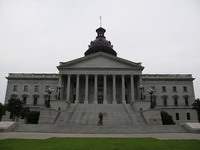Login form
South Carolina

South Carolina has sandy ocean beaches, fine gardens, and high mountains. In addition to outdoor activities, the state offers opportunities to take in America’s past. South Carolina was one of the 13 original English colonies. It preserves buildings from the colonial period, especially in the city of Charleston. In 1861, the first shots of the American Civil War were fired in Charleston’s harbor.
THE PALMETTO STATE
South Carolina is nicknamed the Palmetto State after its state tree, the cabbage palmetto. Palmettos are shaggy palm trees that grow along the Atlantic Coast. People used to chop up the budding leaves of these trees and make a cabbage-like salad.
|
Facts About South Carolina |
|
|
|
|
|
Capital |
Columbia |
|
Population |
4,150,000 people |
|
Rank among states in population |
25th |
|
Major cities |
Columbia, Charleston, Greenville |
|
Area |
32,000 square miles |
|
Rank among states in area |
40th |
|
Statehood |
May 23, 1788, the 8th state |
|
State nickname |
The Palmetto State |
|
Name for residents |
South Carolinians |
|
State bird |
Carolina Wren |
|
State flower |
Yellow Jessamine |
|
State tree |
Palmetto |
|
Abbreviation |
SC |
SWAMPS TO MOUNTAINS
South Carolina is divided into low country and upcountry. The low country is a low-lying plain near the coast. It includes the Sea Islands off the coast. Much of the land near South Carolina’s coast is swamp.
Away from the coast, South Carolina gradually rises into upcountry—rolling hills and mountains. The Blue Ridge Mountains cover the northwest corner of the state. Mists make these tree-covered mountains look blue from a distance.
STATEHOOD
On May 23, 1788, South Carolina became the eighth state to join the United States. Columbia is the capital and largest city. Charleston is the second largest city and an important historic center.
South Carolina remained a farming state into the 1900s. Cotton and tobacco have been the state’s leading crops. Manufacturing started slowly. Today, cotton and chemicals are two of the most important manufactured products. Tourism is also big business in South Carolina.
FIRST SHOTS OF THE CIVIL WAR
On December 20, 1860, South Carolina officially left the United States. It was the first state to secede (break away) from the Union before the American Civil War (1861-1865). Later, 10 more Southern states seceded. These 11 states formed the Confederate States of America. All of these states relied on slaves to work their farmland.
The Civil War started in South Carolina in April 1861. Confederate soldiers bombarded and captured Fort Sumter in Charleston Harbor. United States president Abraham Lincoln decided that the North would fight back. The Civil War was fought to hold the United States together. Today, you can visit Fort Sumter National Monument. Exhibits here help explain the causes of the tragic conflict that divided the North and South.
CHARLESTON
Charleston is the oldest city in South Carolina. It was founded in 1670. During the 1700s, it became one of the largest cities in the American colonies. It thrived as a port for the southern colonies.
Today, Charleston draws many tourists. Its historic district along the waterfront preserves elegant homes and other old buildings. Many of the houses have tall porches and broad balconies to catch sea breezes on hot summer days. In Charleston, you can see the street that inspired Catfish Row in the operetta Porgy and Bess by George Gershwin.
Charleston is still a busy port city. It’s also a major cultural center of the American South. Every spring, Charleston hosts the Spoleto Festival USA. It’s an international festival that includes music, dance, and theater.
GARDENS
South Carolina is known for fine gardens. At Magnolia Gardens and Middleton Place, azaleas and camellias bloom in abundance in early spring. At Cypress Gardens, you can tour a swamp in a flatbottom boat. Cypress Gardens also has a butterfly house, an aquarium, and a reptile center. All three of these gardens are near Charleston.
If you prefer mountains to gardens, you can go hiking or camping in Table Rock State Park in the Blue Ridge Mountains.
THE SEA ISLANDS
Low islands known as the Sea Islands lie off the coast of South Carolina. They generally have sandy beaches on their ocean side and marshes on the side facing the mainland. Groves of palmetto trees grow on the islands.
Hilton Head Island and Myrtle Beach are fancy resorts in the Sea Islands. The Marine Corps runs a training camp for new recruits on Parris Island. It’s called boot camp because new marines were once called boots.
THE GULLAH PEOPLE
The Gullah people live on the Sea Islands. They are descendants of West Africans who once worked as slaves on rice plantations on the islands. The freed slaves stayed on after the plantation owners left during the Civil War (1861-1865).
The Gullah lived largely in isolation until the late 1900s. They fished and continued to grow rice. They kept their heritage and their language, which is also called Gullah. Gullah combines English words with words and grammar from West African languages. Gullah words that have entered English include goober (meaning “peanut”) and gumbo (a stew made with the vegetable okra).
Every May, the city of Beaufort on Port Royal Island hosts a Gullah Festival. This is where you can learn about Gullah culture—hear the music, watch the dances, see the crafts, and sample the foods of the Gullah people.
Source: Microsoft ® Encarta

